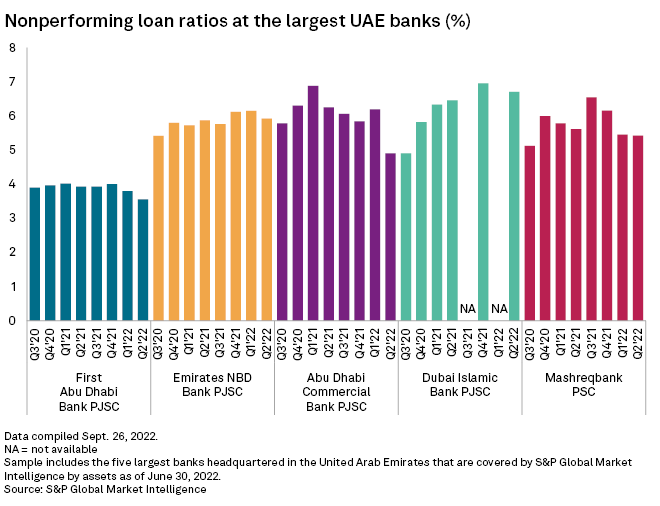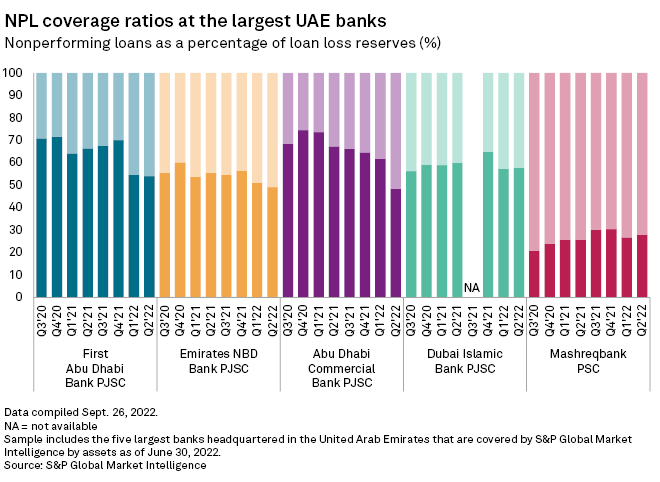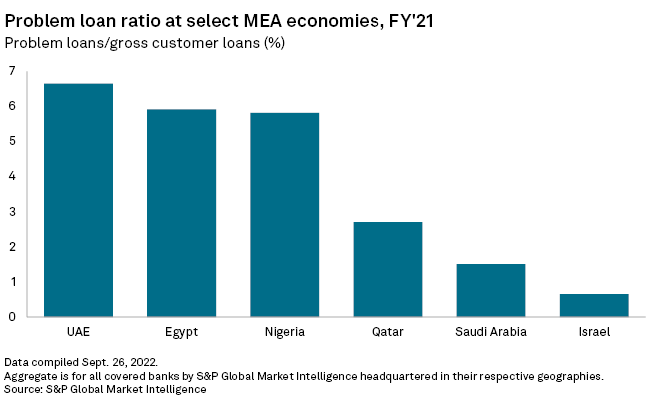| The UAE has some of the highest levels of non-performing loans among major economies in the Middle East and Africa, in part due to its high exposure to the construction sector. Credit: Dan Kitwood/Getty Images News via Getty Images Europe |
According to market watchers, bank sales of non-performing loan portfolios in the UAE will become more common as lenders prioritize cleaning up their books and improved regulations increase the attractiveness of such transactions for the buyers.
Abu Dhabi Commercial Bank PJSC, or ADCB, is selling about $1.1 billion in bad debt, including personal and corporate loans and real estate assets, Bloomberg News reported in September. It would be the largest non-performing loan, or NPL, portfolio sale of its kind in the United Arab Emirates, said Jaap Meijer, managing director of research at Dubai-based Arqaam Capital.
Local subsidiaries of international banks have had moderate sized sales of NPL wallets, while transactions involving individual borrowers have been taking place for some time, said James Dervin, managing director of Alvarez & Marsal Middle East.
Yet few of these transactions, some of which involved international investment firms, have been made public. One exception was asset manager and investment bank SHUAA Capital PSC’s January 2021 acquisition of 1.13 billion UAE dirhams of debt owed by Stanford Marine Group to various lenders.
“It’s not a deep market and trading is rare, which is why the sale of ADCB is of such importance,” said Michael Rainey, partner at law firm King & Spalding in Dubai.
Cleaning the loan book
The sale of loans being considered by the ADCB will benefit the bank by giving it “a lower overall number of NPLs with no negative impact on the income statement as the loans have been fully written off or are fully provisioned on a net basis”, it said. said Meijer. It will also free up management time to move the business forward instead of managing legacy positions, as the ADCB has been hit by several corporate bankruptcies in recent years, he said.
The most notable of these failures was Abu Dhabi’s NMC Health PLC, which in 2020 admitted to making a “significant misrepresentation of its debt position in its financial accounts”, according to the ADCB’s annual report. The bank backed a motion to place NMC Health into administration and awarded the company and associated entities most of its deficiencies. The ADCB declined a request for comment.
The bank has already made progress in reducing its NPL ratio, which stood at 4.91% in the second quarter, down from 6.19% in the previous quarter and 6.26% a year ago, the data shows. from S&P Global Market Intelligence.

ADCB’s NPL coverage ratio of 48.5% in the second quarter was lower than its peers First Abu Dhabi Bank PJSC, Emirates NBD Bank PJSC and Dubai Islamic Bank PJSC. Among the five largest banks in the UAE, only Mashreqbank PSC had a bad debt coverage ratio below ADCB for the period at 27.9%.

Increased risk
The UAE’s problem loan ratio is higher than that of many major economies in the Middle East and Africa, according to data from Market Intelligence.

According to S&P Global Ratings, UAE banks are exposed to very high credit risks given the industry’s aggressive lending and underwriting practices and structurally high concentration in the real estate and construction sectors. Loan portfolios are typically concentrated in a single name, and banks also have significant exposure to some troubled government-linked entities, the agency wrote in a July report.
Credit losses have historically been higher among UAE banks than in the rest of the Gulf Cooperation Council, Meijer said, although the strength of the economy means the formation of new NPLs is quite limited. Ratings forecast Stage 3 – or non-performing – loans from UAE banks will be 5.8% to 6.2% in 2022-23 from 6.1% at the end of last year.
The business case for banks selling NPLs is compelling, according to Dervin. “By assuming a selling price above amortized value, not only do you get improved financial performance, but you’re also freed from the capital restrictions associated with non-performing loans,” he said.
The likely discount buyers can expect to receive on the face value of NPLs depends on the specifics of the loan(s) in question, as well as external factors such as jurisdiction and the strength of enforcement mechanisms in that jurisdiction, a said Dervin.
Regulatory challenges
A “historically useless legal regime” and “negative attitudes towards financial distress that often result in a mere shuffling of deckchairs” were key factors in the slow development of the UAE’s distressed debt market, according to a July memo from the Mayer Brown law firm.
The UAE’s recent mortgage law and civil code allow for the concept of assignment – a third party taking possession of an existing debt – but it has not been used often and the requirements are not “particularly clear”, wrote Mayer Brown.
Instead, dBuyers of distressed debt who do not have a local lending license typically act in the market through an “equity” where the buyer acquires the rights to the debt but the seller remains the legal owner.
“It’s not a mechanism unique to the region. It’s a feature of developed markets when the seller and the buyer trade in this way just because they don’t want to make it public,” Dervin said. , adding that in some cases, a lender’s ability to exit the position may be limited by the original loan documents or other regulatory considerations.
U.S.- or European-based distressed-debt funds considering buying NPL portfolios in the Middle East should analyze all regulatory challenges before even thinking about making a deal, Rainey said.
“If you were to purchase a non-performing loan, there is a potential regulatory issue as to whether you can even hold such a loan because lending activity, including holding third-party originated loans, is generally considered a regulated activity,” Rainy said.
bright future
Mayer Brown notes that considerable progress has been made in recent years to overcome these problems, including the introduction of a new corporate insolvency regime.
In early 2020, India and the UAE agreed to make the verdicts of the UAE courts on enforceable defaults in India. Historically, loans in the UAE have been secured by commonly requested guarantees and post-dated checks, but recent legal changes allow creditors to secure a debtor’s floating assets such as bank accounts and inventory receivables, a said Rainey.
For the sale of the ADCB, the lender may seek the blessing of the UAE central bank before completing the transaction, Rainey noted. A positive result could give other banks and investors greater confidence in pursuing similar operations in the future.
“As regulation, recognition and legislative regimes improve, the prospects for recovery increase and therefore the potential attractiveness and viability of a market increases,” Dervin said.
As of October 25, 1 dollar was equivalent to 3.67 UAE dirhams.



